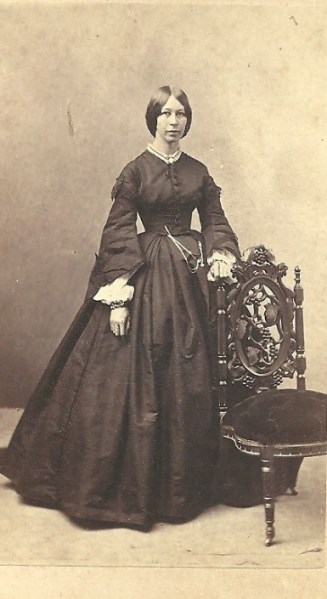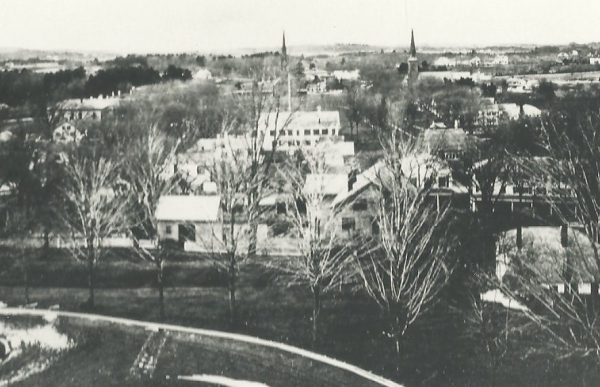Miss Moulton (1831 – 1922) was the teacher in the one-room schoolhouse located on the lot on Edgell Road where Nobscot Park is now. She was an excellent teacher; in its report for 1855-56 the School Committee wrote:
Miss Moulton has the happy faculty to maintain perfect order, without producing an automaton stiffness, and without the sacrifice of constant interest in study and recitations. Each scholar was trained to independent thought; and with an almost endless variety of exercises, interspersed among the regular school duties, there was none without a good tendency and aim. She made her school, in every sense, a model school.

In 1860 she was moved to the intermediate school at District 1 in Framingham Centre, “composed of children of various ages, who are not far enough advanced to enter the Grammar Department.” Here she also earned high praise from the School Committee:
Miss Moulton has been long and most favorably known as an accomplished and successful instructress, and her labors in this department have been very satisfactory… The order of the school has been unexceptionable, throughout the year. The children have been most faithfully drilled, in all their studies… In mental arithmetic and reading, the exercises of the pupils give evidence of much improvement. The unanimous feeling of the district is approbation of the excellent condition of the school.
In 1868 Miss Moulton gave up teaching and took over a bookstore in Framingham Centre. Later she moved to her own house on High Street where she opened a shop. She sold newspapers and magazines and various “fancy goods.” Ladies, Like Julia Hurd of Church St., could stop in to buy stockings, handkerchiefs, sewing supplies or greeting cards. They also brought Miss Moulton gifts of baked goods, or vegetables and fruit from their gardens and orchards. Her old scholars came to visit as well, the Nobscot schoolchildren now grown men and women.

(From a scrapbook of photographs at Framingham History Center)
After fifty-two years in business Miss Moulton sold her shop in 1920 and went to live with a nephew in Vermont. She died in 1922 at the age of ninety-one.
Why did she leave teaching when she was so good at it? Was it just because she wanted to be independent and decide for herself when her work was good? Was it because of the low salary? In 1860-61 she earned $186 for twenty-eight weeks of teaching. Was it because of the unfairness of paying women teachers half the amount a man would earn? (In the report of 1853-54 the School Committee announced that it had now replaced all the male common school teachers with females, thus saving enough to offer an additional term each year.)
Facts
Miss Moulton’s father was a carpenter. He built a house, shop and barn for his daughter in the 1860s. This “Moulton Block” was torn down in the 1930s to make way for widening Route 9.
Bibliography
Framingham Evening News. “Leaves for new scenes, long in business here.” [25 Jun. 1920] Photocopy.
Framingham Evening News. “Agency for newspapers, half century; Miss Moulton, long in business at Framingham Centre, passes away in 91st year.” 24 May 1922. Photocopy.
Framingham in 1876: Ladies Contribution to Centennial Exposition, Philadelphia. Scrapbook of a series of photographs by A. H. Folsom. [c.1976]
Framingham, Mass. School Committee. Report of the School Committee of the Town of Framingham, 1853-54; 1855-56; 1860-61. Framingham, 1854-61.
Hurd, Julia. Framingham Grandmother: The Diary of Julia Hurd, 1909-1914, transcribed by Martha Davidson. 2000. Entries for 2 Aug.1911; 2 May, 2 Dec. 1913.
Rice, Harry C. Letter, 24 Jun. 1931, to Members of the Historical Society about houses on High Street about to be razed for widening of Route 9.